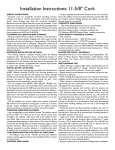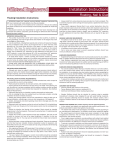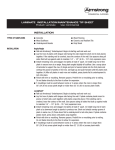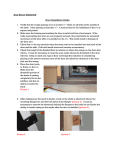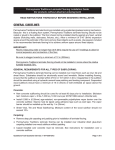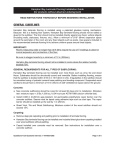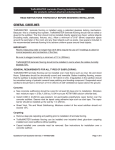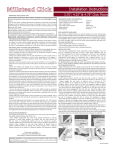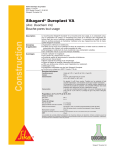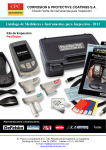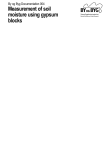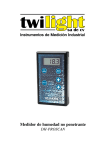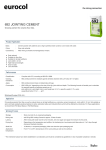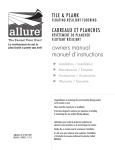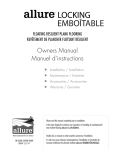Download Heritage Mill PF9656 Installation Guide
Transcript
Installation Instructions: 5.5” Cork Jobsite Conditions: • Structure must be completely enclosed (including exterior windows and doors). Gutters, downspouts, and exterior grading should direct drainage away from the structures foundation. Basements and crawl spaces must be dry and well ventilated. Crawl spaces must be covered at ground level with a 6-mil polyethylene film with seams overlapped and tapped completely. • Heating and cooling systems must be operating for a minimum of 14 days, maintaining a room temperature of 65F and 35-65% RH. Flooring Acclimation and Storage: • Flooring requires 48 hours jobsite acclimation. Leave flooring in packaging, and remove plastic wrapping only when ready to install. Transport and store cork flooring in a laying position. If the flooring needs to be stored, leave in packaging, laying down raised off of subfloor (fully supported to prevent sagging). Store only in a climate controlled area, minimum 65F room temperature, between 35-65% Relative Humidity. Approved Installation Method: • This flooring features a glueless locking system for floating installation only. This flooring is factory finished and requires no additional sealing. Note:This flooring does not require a cushioned underlayment as the bottom cork layer serves this purpose. All installations do require a polyethylene film moisture vapor barrier as noted in the “Installing The Floor” section. Installation Locations: • Indoors only, in year round climate controlled rooms (temperature 60-80F, Relative Humidity 35-65%). Cork flooring products are based on natural materials and will expand and contact through heating and non-heating seasons thus experiencing some separation between the planks at different times during the year. Such separations are not considered a product defect. • Can be installed ON, ABOVE, AND BELOW GRADE over most any dry, flat, clean, and structurally sound solid surface such as flooring grade plywood & OSB board, particle board, concrete, lightweight concrete, and soundly secured existing floors (linoleum, vinyl, tile, etc.). Do not install over soft surfaces such as carpet. Not approved or warranted for installation in a full bath. Cork flooring planks and stairnose moldings also are not approved for use on stair treads. • Can be installed over in-floor radiant heat systems (maximum 82F, maximum 5F temperature change plus or minus in a 24 hour period). Follow installation instructions of the subfloor heating system manufacturer, contractor, or contact the system supplier. Checking Subfloor Flatness: • Use a straightedge to check subfloor flatness. The subfloor should be flat to within .12” (1/8”) in a 6-1/2’ area. Check various areas throughout the subfloor. High areas need to be sanded and low areas filled. High or low areas could cause the floated floor to flex causing squeaking, popping, or other noises. Over time this flexing could cause the locking system to weaken resulting in gaps or loose boards in the floor. Never sand any area or existing floor or cured adhesive suspected to contain asbestos or crystalline silica (such as resilient vinyl or linoleum, or the adhesives used to bond them). Checking Moisture Content of Subfloor: • All subfloors must be dry. Wooden and concrete subfloors require insulation against moisture. See “Installing the Floor” section for added details. Wooden Subfloors: • Using a reputable manufacturers moisture meter for wood subfloors, the subfloors moisture content should not exceed 14%. Also, the moisture content readings between the subfloor and the new flooring should not exceed 4%. Concrete Subfloors: One of the following moisture tests is recommended: (A) Calcium Chloride Test / maximum 3.0 pounds (B) Tramex Moisture Meter / maximum reading of 4.5 (C) Delmhorst BD2100 Moisture Meter / reading of green/dry. Lightweight Concrete Floors: Test as follows: (A) For concrete screeds / <2,0% CM Instrument (B) For anhydrite screeds / <0,5% CM Instrument • Keep documentation of all moisture readings. If results indicate a moisture problem exists, DO NOT INSTALL THE FLOOR. Most moisture problems can be corrected easily (sealing, etc..). When corrected, retest the subfloor.. Suggested Tools / Materials: Polyethylene Film (2 or 6 mil), Adhesive tape, Tapping Block, 3/8” Wood or Plastic Spacers, Measuring Tape, Safety Glasses, Dust Mask, Chalk Line, Square, Pencil, Wood Chisel, Circular or Rip Saw, Jamb Saw Pre-Planning Tips: • Inspect flooring in adequate light before installing. Remove any boards with visible defects or damage. Defective flooring that is returned unused will be replaced. Contact your supplier. • Slightly bowed (curved) boards can be installed and are not considered to be defective. • When installing flooring, always work from several cartons blending lighter and darker boards to achieve a more uniform appearance. • When cutting or sanding Engineered Cork Flooring it is recommended that you wear a dust mask to avoid inhaling wood dust, and safety glasses for eye protection. • A floating floor expands and contracts with the seasons and should never be restricted in any way. This floating floor requires a 3/8” expansion space around the perimeter of the room, and around any vertical object (cabinets, columns, etc.). Be careful not to put fasteners (nails, screws, etc.) through the floor or “pinch” the floor under doorways, cabinets, etc.. This could cause the floor to pull apart or buckle if it is not allowed to float freely. Be especially careful when installing moldings and trim not to nail through the floating floor. • Decide the direction the flooring will be installed in the room. If possible, it is best to install perpendicular to the direction of the flooring joists. Flooring will be accented best if installed parallel to the largest windows in the room. • Larger areas require additional expansion space. In areas larger than 24 ft. length in either direction, allow an additional ¼” space for every 12 ft. in length above 24 ft. (Example: For a 36’x36’ size room, allow 5/8” expansion (normal 3/8” plus ¼” space for the 12’ above 24’) around the perimeter of the room. • Pre-plan the number of rows (base off of board face width). Often the last row will need to be ripped lengthwise to fit. If the measurement for the last row is less than 2”, it would be best to rip the boards in the first and last rows for balance. If the boards have to be narrower that 2”, use a high quality carpenters glue to secure the boards to the wider adjoining boards. • Remove any base, shoe, or threshold moldings before installation. • Undercut door jambs to allow for expansion and to avoid difficult scribe cuts. Use a small piece of your flooring as a rest for the jamb saw during cutting. • The use of putty to fill small gaps or correct minor defects is considered normal in any flooring installation. Installing the Floor: Call 1-800-258-5758 for assistance if required. Over Concrete Subfloors: • Loose-lay 1 layer of polyethylene film (minimum 2-mil, preferred 6-mil) as a moisture vapor barrier. Overlap the seams of the poly by 8” and tape the seams completely with clear packaging tape. Poly should be lapped up the wall but not touching the sheetrock. • Installation Tip: If you need to cover the floor during or after the installation we recommend covering with a breathable material such as cardboard, craft paper, etc. • (Figure 1). Begin laying the flooring in the right corner of the room.All boards should be installed with the tongue side facing the wall. To determine the tongue side, look down directly from above at the finished side of the board. Along both of the long sides of the board you will see fiberboard showing that is the locking core. The side with the narrowest amount of core material showing is the tongue side. This is the side that should face the wall. Installation Tip: Note that slightly bowed (curved) boards can be installed and are not considered defective. There are a few tips that can help make installing these boards easier. 1. When placing the bowed board at an angle into the side groove of the row being installed into, apply pressure to engage the boards as usual rotating the bowed board downwards. 2. As you meet resistance, hold the bowed board near its’ center and apply downward pressure. 3. Use a tapping block to tap against the groove side of the bowed board while continuing to apply downward pressure until the board engages and goes into the proper flat position. Do not tap too hard as this can damage the groove side of the board being installed. • Lay the first board in the right corner flat on the poly film. Install 3/8” spacers to maintain the required expansion space against the wall (and around the perimeter of the room as you progress) as necessary. Tightly align the end of the second board with the first and join these two boards by simply folding it down on top of the end groove of the first board (Figure 2). Make sure that the long sides of the two boards form a straight line. Repeat these steps to complete the boards in the first row. Usually the last board in the row will need to be cut to size. If leftover cut pieces are longer than 12” they can be used as starter boards for other rows. Installation tip: • To assist with the stability of the first few rows, we recommend that you install the first row, the 2 boards in the second row, then 1 board in the third row. Go back to the second row to install 1 board, then back to the third row to install 1 board. Repeat this “stepping” pattern until the three rows are completed. Always stagger the end joints of adjoining rows a minimum of 12”. Try to avoid a “stair step” pattern, and try to avoid “H” joints in the installation. • Figure 3: Start the second row by holding the long side of the board at an angle to the first board in the first row. Make sure the tongue of the board being installed is aligned properly with the groove of the first row board. Engage the board sides by rotating the board downward while pressing inward toward the first row flooring (Figure 4). Use a tapping block to assist engaging the boards if necessary. Repeat this step for the other boards as you install them. Cut the last board to size as necessary. Installation Tip: Properly engaged boards will lay flat. You cannot force the boards to go together, and if they are not laying flat when engaged they are not fully seated. Disengage the board by lifting the side of the board at an angle to remove. Reinstall the board and use a tapping block to assist in securing the boards together until they lay flat. • Install the third and remaining rows in the same manner as described above. Once three rows have been installed, recheck the spacers to be sure they are tight against the wall. If necessary, adjust the flooring to be sure the installation is square (Figure 5). • The boards in the last row often need to be ripped lengthwise to the needed width (be sure to allow for required expansion space). Mark the board to be ripped accordingly allowing for any wall contours as required. The boards in the last row should be at least 2” wide. Installation Tip: When working under door jambs or the toe kicks of cabinets, there will not be enough clearance to get enough angle necessary to engage the board sides. It will be necessary to trim away the raised portion on the groove side using a wood chisel and then glue the boards together using a high quality carpenter’s glue. • After the floor is completely installed, remove spacers, install moldings and thoroughly clean the floor with an approved hardwood floor cleaner (call 1-800-258-5758 for a list of approved cleaners). If the floor needs to be covered for protection, use a breathable material like craft paper or cardboard. Never cover a newly installed cork floor with plastic. Tips For Protecting Your Floor: • Regularly vacuum and clean your floor with an approved cleaner. • Protect your floor by placing walk-off mats at all entrances to retain tracked-in dirt, grit and moisture. Use breathable mats,…. never use latex or rubber backed mats that can trap moisture that can damage your floor. • Avoid moisture on the floor. Clean up spills quickly and don’t wet or damp mop your floor. • Use felt pads on chair legs and furniture legs. • Don’t drag or roll heavy objects directly across your floor. Put down a layer of material such as plywood for protection. • Avoid walking on the floor in high heeled shoes or sports shoes with spikes or cleats, • Office roller chairs must comply with DIN68131. • Keep pets nails trimmed as closely as possible. • The exposure to sun, UV rays and artificial lighting can fade or change the color of your floor over time. If possible, we recommend that you rearrange fixtures, rugs, and furniture periodically to ensure the floor ages evenly. Our warranties do not cover damage from the sun, UV rays, or artificial light.


